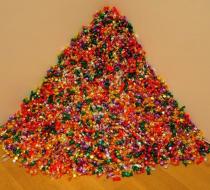“Untitled” (Portrait of Ross in L.A.) Favorite
Artist: Félix González-Torres
Media: Candies in variously coloured wrappers, endless supply, ideal weight of 175 lb
Date & Location: 1991
Where can I find this item?: Art Institute of Chicago, Contemporary Art, Gallery 293
Source: Wikimedia Commons (Creative Commons)
Significance to Queer Art History
Félix González-Torres (1957-1996) started a series of works in 1990 that all consist of small, hard candies in variously coloured wrappers. They are either spread out in rectangles on floors or put into piles. Some other works in this series are called Untitled (Lover Boys) and Untitled (Welcome Back Heroes). In each instance viewers are invited to take a piece of candy—to suck on, to keep, to share. This, of course, risks the loss of the installation entirely, but the instructions are that they are to be constantly replenished with an endless supply. Untitled (Portrait of Ross in L.A) comes with instructions from the artist to keep it at an ideal weight of 175 lb.
Although it avoids literal representation, this is a work about queer desire, queer bodies, and queer history. It is named after his love and life partner, Ross Laycock, and is about his personal experience of AIDS as well as the AIDS Crisis as a whole. The ‘ideal weight of 175 lb’ is a reference to Ross’ healthy weight, which diminished because of the virus. Ross died from complications due to AIDS on January 24th, 1991, and Félix would go on to make this work later that same year. If you like, here you can read a tribute to Ross written by someone who knew him.
In media about the AIDS Crisis queer bodies and lives are often obscured by statistics or sensationalizing photographs, but Félix’s installations refuse to participate in this cycle (Blocker, 2009). His candy is related to the queer body only through the title, the weight, and a moment of agreement with viewers (Lorenz, 2012). Renate Lorenz describes this piece as a form of queer embodiment that “links itself to historical moments or other bodies” and emerges only in moments of connecting.
As visitors to the gallery take the candies (as they are invited to do) it speaks to the weight loss experienced by Ross as he fought the virus. Félix said of a similar installation where visitors where invited to take sheets of paper:
I wanted people to have my work…. In a way this “letting go” of the work, this refusal to make a static form, a monolithic sculpture, in favor of a disappearing, changing, unstable, and fragile form was an attempt on my part to rehearse my fears of having Ross disappear day by day right in front of my eyes.
Félix González-Torres, Interview with Tom Rollins, 1993.
His instructions for this work, though, also call for endless replenishment keeping this queer embodiment dedicated to Ross at a healthy weight and they invite engagement evocative of queer desire and sex. As audiences pick up and enjoy sucking on the candies—here fantasized as a queer, HIV-positive body by artist and audience—it also allows for a destigmatizing, a returning of pleasure to acts deemed taboo by moralized media and voyeuristic representations of queer lives.
We have an assigned role that’s very specific, very limited. As in a glass vitrine, ‘we’—the ‘other’—have to accomplish ritual, exotic performances to satisfy the needs of the majority…. Who is going to define my culture? It’s not just Borges and García Márquez, but also Gertrude Stein and Freud and Guy Debord—they are all part of my formation.
Félix González-Torres, quoted by José Esteban Muñoz, 1999.
This work is an important part of queer art history for so many reasons: it invites a queer politics to art making by being a work that can be remade anywhere without the touch of the artist and is ever-changing; it is about one queer body and simultaneously so many queer bodies; it is from and about a moment of queer history and its ongoing legacies, and it continues to create new moments of queer connection across bodies and moments.
Félix González-Torres, Billboard, 1989
Other works by Félix speak even more specifically to queer ways of engaging history. A billboard he made in 1989 reads: “People with AIDS Coalition 1985 Police Harassment 1969 Oscar Wilde 1895 Supreme Court 1986 Harvey Milk 1977 March on Washington 1987 Stonewall Rebellion 1969.” Jane Blocker writes that “by daring to be a queer witness, [Félix] shows how history itself is queer, how it is made not of single comprehensible events and their representations but of different versions of the same, of repetitions and doublings.” He conceptualizes a queer history that laps back to touch moment to moment: the persecution of Oscar Wilde connects to police harassment in New York, the Stonewall Rebellion to the People with AIDS Coalition. We could expand this practice much further into history, bringing queer moments and bodies to touch.
Resource(s)
Nancy Spector. Félix González-Torres. New York: Guggenheim Museum, 2007.
Jane Blocker. Seeing witness: visuality and the ethics of testimony. Minnesota: University of Minnesota Press, 2009.
Renate Lorenz. Queer Art. Transcript. 2012.






